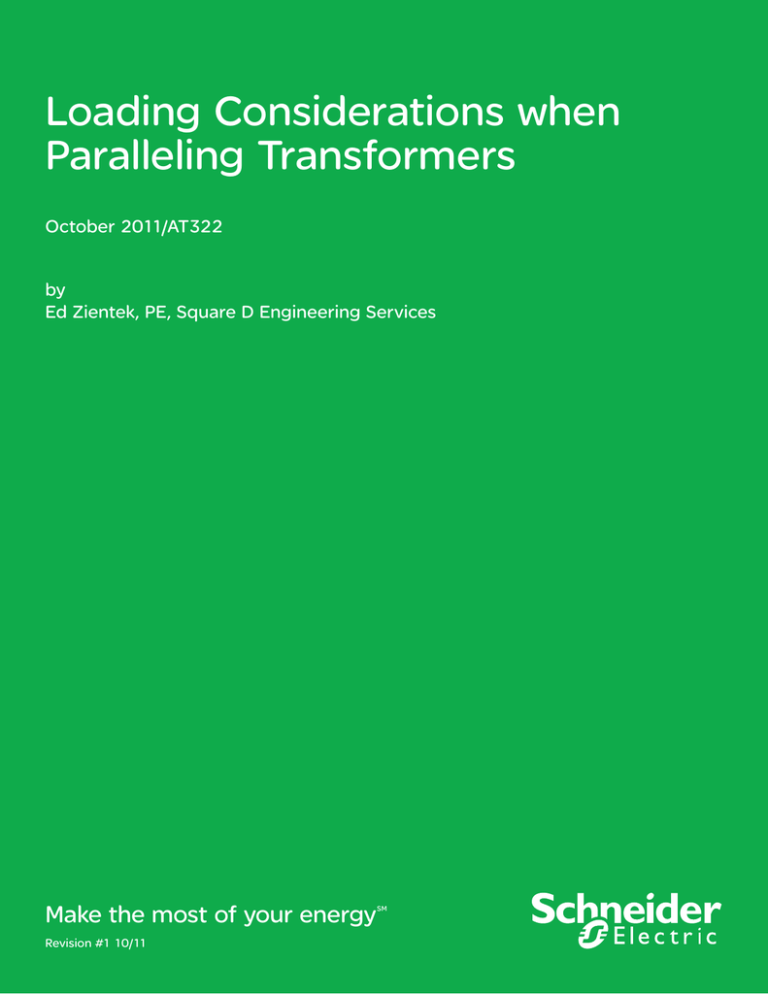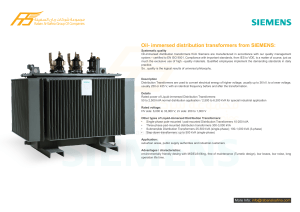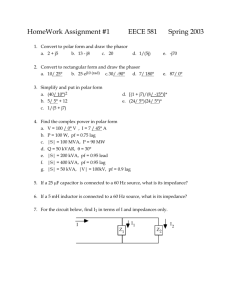Loading Considerations when Paralleling Transformers
advertisement

Loading Considerations when Paralleling Transformers October 2011/AT322 by Ed Zientek, PE, Square D Engineering Services Make the most of your energy Revision #1 10/11 SM Loading considerations when paralleling transformers Summary Abstract............................................................................................................ p3 Introduction...................................................................................................... p 4 Principles of Paralleling..................................................................................... p 5 Get connected to power Limiting Conditions........................................................................................... p 6 Equal Impedances – Equal Ratios..................................................................... p 7 •Same kVA..................................................................................................... p7 •Different kVA................................................................................................. p9 Unequal Impedances – Equal Ratios................................................................. p 10 •Same kVA..................................................................................................... p10 •Different kVA................................................................................................. p11 Unequal Impedances – Unequal Ratios............................................................ p 12 •Same kVA..................................................................................................... p12 •Different kVA................................................................................................. p14 Delta-Delta to Delta-Wye................................................................................... p15 Conclusion....................................................................................................... p16 AT322 | 2 Loading considerations when paralleling transformers Abstract Sometimes existing transformers are paralleled in industrial and commercial facilities when facility engineers, consultants or maintenance staffs are looking for ways of making power systems more reliable, provide better power quality, prevent voltage sags, or for additional load requirements. This article addresses the limiting conditions of connecting transformers in parallel and loading considerations when turn ratios, impedances and kVA ratings are different. Most engineers know that these parameters are important when paralleling transformers but there are some misconceptions of when circulating currents actually exist. Get connected to power AT322 | 3 Loading considerations when paralleling transformers Introduction Electrical systems have been using paralleled transformers for many years. Electrical utilities are ideal examples of these applications. Their main objectives are reliability and power quality along with keeping consumers on-line. Utility power engineers understand very well the operation of paralleling transformers when it comes to load sharing between transformers and when circulating currents exist. Many times auto-tap transformers are used to adjust voltage levels due to loading conditions. Oftentimes these tap changes produce circulating current in parallel-operated transformers. Get connected to power Power engineers in industrial and commercial facilities are less likely to understand circulating currents and load sharing because most transformers installed in parallel have the same kVA, turn ratios and impedances. However, as systems change over time, and transformers are replaced or added, then users need to know the impact of paralleling transformers with different parameters. This article will address the following when paralleling transformers. 1.Principles of Paralleling 2.Limiting Conditions 3.Equal Impedances – Equal ratios – Same kVA 4.Equal Impedances – Equal ratios – Different kVA 5.Unequal Impedances – Equal ratios – Same kVA 6.Unequal Impedances – Equal ratios – Different kVA 7.Unequal Impedances – Unequal ratios – Same kVA 8.Unequal Impedances – Unequal ratios – Different kVA 9.Delta-Delta to Delta-Wye AT322 | 4 Loading considerations when paralleling transformers Principles of Paralleling Transformers connected in parallel have the same voltage on the primary and the secondary winding terminals. The difference in the voltage between the primary and secondary windings is the turns ratio. For these terminal voltages to be the same for the paralleled transformers their impedance drop must be identical. Therefore, under any condition of load, the current will be divided such that the product of impedance and current in one transformer is equal to the product of impedance and current in the other. Also, if the turn ratios of the transformers are different, but the primary and secondary terminal voltages are the same in both transformers, then circulating currents must be flowing between the transformers Get connected to power even at no load. AT322 | 5 Loading considerations when paralleling transformers Limiting Conditions Transformers are suitable for parallel operation when their turn ratios, percent impedances and X/R ratios are the same. Connecting transformers when one of these parameters is different, results in either circulating currents or unwanted current division. Both of these situations lower the efficiency and reduce the maximum Reference: amount of load the combined transformers can carry. [1] L.F. Blume, Chapter VII, Transformer Connections Typically, transformers should not be operated in parallel when the following conditions exist: 1.When the division of load is such that, with the total load current equal to the combined kVA rating of the transformers, one of the transformers is overloaded. 2.When the no-load circulating currents in any transformer exceed 10% of the full load rating[1]. 3.When the combination of the circulating currents and full load current exceed the full load rating of either transformer. Above, the circulating currents are the current flowing at no load in the high and low voltage windings absent of exciting currents. Full load current is the current flowing in the transformer with a load connected, absent of exciting and circulating currents. Below, Table 1 is an overall summary of different connection types of parallel transformers. Refer to Sections V – X page 7-11 for explanations and calculations of these different connection types. Table 1: Overall connection summary Transformer Parallel Connection Types Equal Loading Unequal Loading Over Loading Concerns Circulating Currents Recommended Connection Same kVA Yes No No No Yes Different kVA No Yes No No Yes Unequal Impedances – Equal Ratios Same kVA No Yes Yes No No Different kVA No Yes Yes No No Unequal Impedances – Unequal Ratios Same kVA Yes No Yes Yes No Different kVA No Yes Yes Yes No Equal Impedances – Equal Ratios FPO: Information is not match with page 4 and 10 AT322 | 6 Loading considerations when paralleling transformers Equal Impedances – Equal Ratios Same kVA The standard method of connecting transformers in parallel is to have the same turn ratios, percent impedances, and kVA ratings. This is typically accomplished by maintaining a tie breaker in the normally closed (N.C.) position. Connecting transformers in parallel with the same parameters results in equal load sharing and no circulating currents in the windings of the transformers. Example 1 shows calculations for this scenario. Refer to Figure 1 and Figure 2 for this typical arrangement. Figure 1: Typical parallel operation Figure 2: Typical single phase parallel operation Get connected to power AT322 | 7 Loading considerations when paralleling transformers It can be seen by using equations (1) and (2) below, that if the percent impedances in each transformer are the same, as shown in Figure 1, that there will be equal current division and load sharing on each transformer. (1) (2) Where I1 = load current from transformer 1 I2 = load current from transformer 2 Z1= % impedance of transformer 1 Z2= % impedance of transformer 2 The total load current IL = I1 + I2 Substituting for Z1 and Z2 below into equations (1) and (2) produces the following equations (3) and (4): (3) (4) Where I1 = load current from transformer 1 I2 = load current from transformer 2 Z1= % impedance of transformer 1 Z2= % impedance of transformer 2 kVA1= kVA rating of transformer 1 kVA2= kVA rating of transformer 2 The total load current IL = I1 + I2 Since current has a direct relationship with kVA, substituting kVA for current into equation (3) and (4) above, the same comparison can be made using load kVAL as shown in equations (5) and (6). (5) (6) The above equations are arithmetically correct only when the ratios between the reactances and resistances of the transformers are equal. They give accurate results when X/R ratios are large. In other cases, the sum of the individual load current will be greater than the current in the line. This is because of the phase difference between the currents in the different transformers. AT322 | 8 Loading considerations when paralleling transformers Example 1 Connecting two 2000 kVA, 5.75% impedance transformers in parallel, each with the same turn ratios, to a 4000 kVA load. What is the loading on the transformers? Using equations (5) and (6) shows that there is equal load division between the transformers. kVA1 = kVA2 = 348/(348 + 348) x 4000 kVA = 2000 kVA Different kVA Although its not common practice for new installations, sometimes two transformers with different kVA’s, same percent impedances, are connected to one common bus. In this situation, the current division causes each transformer to carry its rated load. There will be no circulating currents because the voltages (turn ratios) are the same. Example 2 Connecting 3000 kVA and 1000 kVA transformers in parallel, each with 5.75% impedance, each with the same turn ratios, connected to a common 4000 kVA load. What is the loading on each transformer? Using equations (3) and (4) on page 8, kVA1 = 522/(522 + 174) x 4000 = 3000 kVA kVA2 = 174/(522 + 174) x 4000 = 1000 kVA It can be seen by the calculations that even though there are different kVA ratings on transformers, connected to one common load, that current division causes each transformer to only be loaded to its kVA rating. The key here is that the percent impedances are the same. AT322 | 9 Loading considerations when paralleling transformers Unequal Impedances – Equal Ratios Same kVA Frequently in practice, an engineer tries to enhance their plant power system by connecting existing transformers in parallel that have the same kVA rating but with different percent impedances. This is common when budget constraints limit the purchase of a new transformer with the same parameters. What the engineer needs to understand, is that the current divides in inverse proportions to the impedances, Get connected to power and larger current flows through the smaller impedance. Thus, the lower percent impedance transformer can be overloaded when subjected to heavy loading. While the other higher percent impedance transformer will be lightly loaded. Example 3 Connecting two (2) 2000 kVA transformers in parallel, one with 5.75% impedance, and the other with 4% impedance, each with the same turn ratios, connected to a common 3500 kVA load. What is the loading on each transformer? Using equations (5) and (6) on page 8, kVA1 = 348/(348 + 500) x 3500 = 1436 kVA kVA2 = 500/(348 + 500) x 3500 = 2064 kVA It can be seen by the example, because transformer percent impedances do not match, they cannot be loaded to there combined kVA rating. Load division between the transformers is not equal. At below combined rated kVA loading, the 4% impedance transformer is overloaded by 3.2%, while the 5.75% impedance transformer is 72% loaded. AT322 | 10 Loading considerations when paralleling transformers Different kVA Seldom are transformers in industrial and commercial facilities connected to one common bus with different kVA and unequal percent impedances. However, there may be that one situation where two single-ended substations may be tied together via bussing or cables to provide better voltage support when starting large motors. If the percent impedances and kVA ratings are different, care should be taken when loading these transformers. As with the unequal percent impedances shown in the “Unequal Impedances – Equal Ratios (Same kVA)” section, the load current carried by the combined transformers will be less than their rated kVA. This can be seen in Example 4, cable impedances between the transformers are ignored. Example 4 Connecting two transformers in parallel with one 3000 kVA (kVA1) with 5.75% impedance, and the other a 1000 kVA (kVA2) with 4% impedance, each with the same turn ratios, connected to a common 3500 kVA load. What is the loading on each transformer? Using equations (5) and (6) on page 8, kVA1 = 522/(522 + 250) x 3500 = 2366 kVA kVA2 = 250/(522 + 250) x 3500 = 1134 kVA As similar to Example 3, because the percent impedance is less in the 1000 kVA transformer, it is overloaded with a less than combined rated load. AT322 | 11 Loading considerations when paralleling transformers Unequal Impedances – Unequal Ratios Same kVA A good example of a system with circulation currents would be a double-ended substation (similar to Figure 1) that normally has the tie breaker “open.” The operator has decided to close the tie breaker to provide loading and voltage support for a heavily loaded transformer on the right side. The heavily loaded transformer’s taps have been adjusted to raise the operating voltage, and the transformer on the left side has been lightly loaded. Now lets see what happens when these two transformers are paralleled without changing the tap on the right transformer to match the left. Refer to Figure 3 for a single-phase diagram of circulating currents described Reference: [1] L.F. Blume, Chapter VII, Transformer Connections above with no load connected. Figure 3: Single-phase diagram with circulating currents – unequal ratios To calculate the circulating currents, we need to express the difference in ratios in the percentage of the normal ratio, the circulating current is obtained by dividing this value by the sum of the impedances of the two transformers. This would be the total impedance through which the circulating current is flowing. Using the following equation (7)[1], (7) %IC = circulating current in the transformers in percentage of the rated current. %R', %Z', %R", %Z" are the percentage resistances and reactances based on the X/R ratio on units kVA' and kVA". k = kVA'/kVA" %e = difference in voltage ratio expressed in percentage of normal. AT322 | 12 Loading considerations when paralleling transformers The following approximate expression is accurate for most cases. It is exact when the X/R ratios in the transformers are equal[1]. (8) Example 5 shows the percent of circulating currents to the full load that occur when the tap connection on one Reference: [1] L.F. Blume, Chapter VII, Transformer Connections transformer is different. Example 5 Using two (2) 2000 kVA transformers connected in parallel, each with 5.75% impedance, same X/R ratio (8), transformer #1 with tap adjusted 2.5% from nominal and transformer #2 tapped at nominal. What is the percent circulating current (%IC) using equations (7) and (8). %Z' = 5.75, therefore %R' = %Z'/[(X/R)2 + 1)]1/2 solving for %X', %R' = 5.75/((8)2 + 1)1/2 %R' = %R" = .713 %X' = %R x (X/R) %X' = %X" = .713 x 8 = 5.7 Using equation (7), Using equation (8), The circulating current is 21.7% of the full load current. This example shows that small difference in voltage causes a large amount of current to circulate. It is important to point out that transformers should always be on the same tap connection. Circulating current is completely independent of the load and load division. If transformers were fully loaded there will be a considerable amount of overheating due to circulating currents. Remember, since circulating currents do not flow on the line, they cannot be measured if monitoring equipment is upstream or down stream of the common connection points. AT322 | 13 Loading considerations when paralleling transformers Unequal Impedances – Unequal Ratios Different kVA Although it appears highly unlikely that all of these parameters would be different in practice, we will address this situation to look at circulating currents. Section VIII “Unequal Impedances – Equal Ratios (Different)” on page 9 addressed different kVA but ignored the X/R ratios of the transformer. If both the ratios and the impedances are different, the circulating current due to the unequal ratio should be Get connected to power combined with each transformer's share of the load current to obtain the actual total current in each unit. For unity power factor, 10% circulating current due to unequal turn ratios results in only half percent to the total current. At lower power factors the circulating current will change dramatically[1]. Example 6 shows the effect of having parallel transformers with different percent impedances, different turn and X/R ratios connected to one common load. Example 6 Using two (2) transformers connected in parallel, 2000 kVA1 with 5.75% impedance, X/R ratio of 8, 1000 kVA2 with 4% impedance, X/R ratio of 5, 2000 kVA1 with tap adjusted 2.5% from nominal and 1000 kVA2 tapped at nominal. What is the percent circulating current (%IC)? %Z' = 5.75, therefore %R' = %Z' / [(X/R)2 + 1)]1/2 solving for %X', %R' = 5.75 / ((8)2 + 1)1/2 %R' = .713 %X'= %R x (X/R) %Z" = 4, therefore %R" = %Z" / [(X/R)2 + 1)]1/2 %R" = .784 solving for %X", %X' = .713 x 8 = 5.7 %R" = 4 / ((5)2 + 1)1/2 %X" = %R x (X/R) %X" = .784 x 5 = 3.92 Using equation (7), The above example shows that the combined load of the transformers will be limited to (.1821 x 3000 = 546 kVA) 2454 kVA before a load is connected. AT322 | 14 Loading considerations when paralleling transformers Delta-Delta to Delta-Wye Paralleling delta-delta to delta-wye transformers should never be attempted. This is because secondary line-ground voltages (assuming balanced voltages) are shifted by 30° in the wye transformer compared to the delta. This causes extremely high circulating currents in the transformers. Using example 5, equation (6), and Figure 4 vectors below. This voltage difference calculates to .517 PU at -75°. The percent circulating current calculates to %IC = 51.7 x 100/11.5 = 449.5. These circulating currents certainly would overheat the transformers. Get connected to power Subtract Voltages between Delta and Wye secondaries: Figure 4: Secondary voltage difference between delta and wye AT322 | 15 Loading considerations when paralleling transformers Conclusion Loading considerations for paralleling transformers are simple unless kVA, percent impedances or ratios are different. When paralleled transformer turn ratios, and percent impedances are the same, there will be equal load division on each transformers. When paralleled transformer kVA ratings are the same, but the percent impedances are different, then unequal load division will occur. The same is true for unequal percent impedances and unequal kVA. Circulating currents only exist if the turn ratios do not match on each transformer. The magnitude of the circulating currents will also depend on the X/R ratios of the transformers. delta-delta to delta-wye transformer paralleling should not be attempted. Get connected to power AT322 | 16 ©2011 Schneider Electric Industries SAS, All Rights Reserved. Schneider Electric USA, Inc. Data Center Solutions 1010 Airpark Center Drive Nashville, TN 37217 615-844-8300 sedatacenters.com Document Number AT322 October 2011 tk


